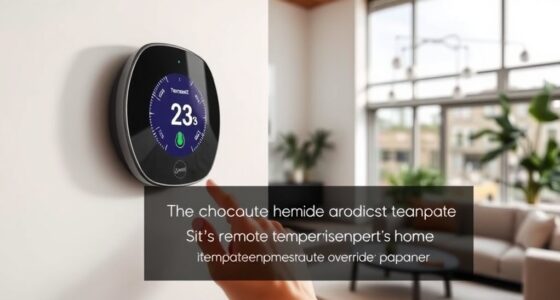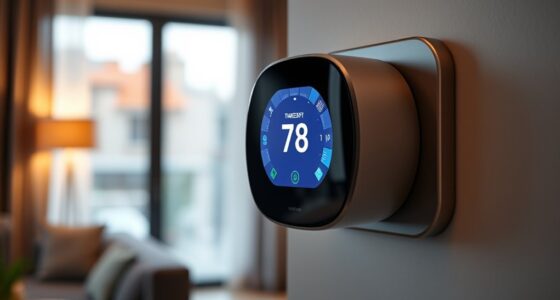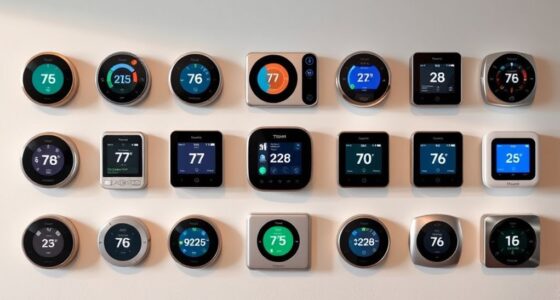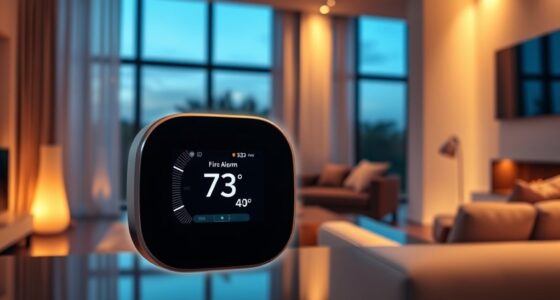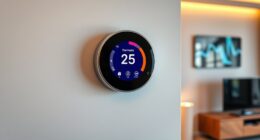If you’re managing multiple properties in 2025, I recommend looking into smart thermostats like ecobee’s models, Nest, and Honeywell that support multi-zone control, energy savings, and remote management. These devices sync across locations, offering user-friendly setups, sensors, and voice assistant compatibility. They’re perfect for maintaining consistent comfort while saving on energy. Keep exploring to discover the top options and features that can make multi-home control easier than ever.
Key Takeaways
- Look for thermostats like ecobee Premium that support multi-property management and multiple zones for seamless control.
- Ensure the device integrates with popular smart home platforms (Google Assistant, Alexa, Apple HomeKit) for centralized management.
- Check if the thermostat offers multi-user access and remote control via mobile apps for easy management across properties.
- Consider models with advanced sensors and energy reports to optimize comfort and efficiency in multiple homes.
- Verify compatibility with various HVAC systems and support for multi-zone setups to suit different property configurations.
ecobee Smart Thermostat Premium with Sensors and Air Quality Monitor
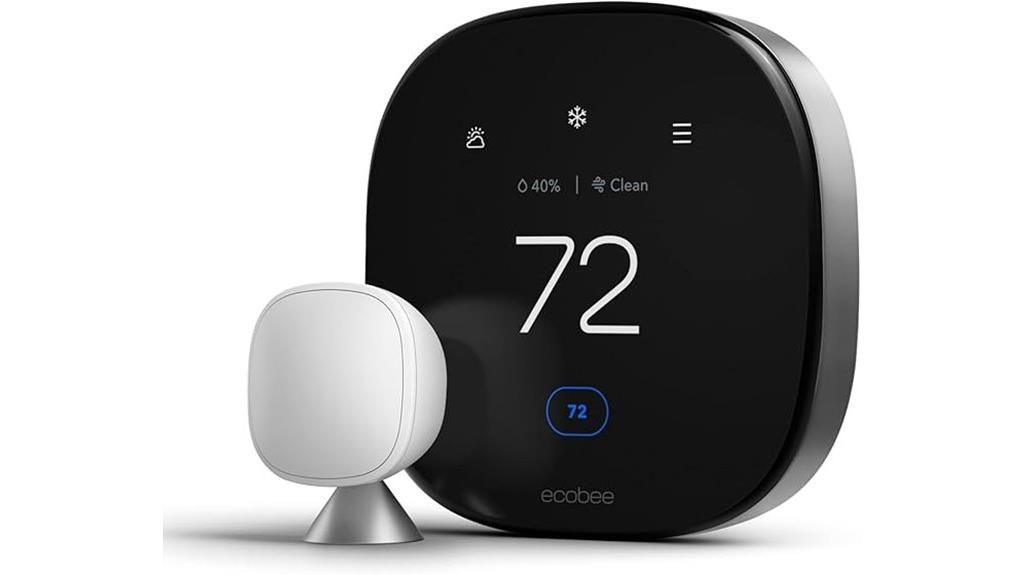
If you’re managing multiple homes, the ecobee Smart Thermostat Premium stands out with its advanced sensors and air quality monitor, making it an excellent choice for maintaining comfort and efficiency across properties. It can save you up to 26% annually on heating and cooling costs and is ENERGY STAR certified. The SmartSensor adjusts temperatures in key rooms, reducing hot and cold spots, while the built-in air quality monitor alerts you to poor air quality and reminds you to change filters. Its sleek design, vibrant display, and compatibility with voice assistants like Siri and Alexa make it both functional and stylish. Plus, it acts as a security hub with smoke detection and alerts for potential intrusions.
Best For: homeowners managing multiple properties seeking energy savings, air quality monitoring, and integrated security features in a stylish, smart thermostat.
Pros:
- Saves up to 26% annually on heating and cooling costs, reducing energy bills.
- Built-in air quality monitor and SmartSensor for optimal comfort and air management.
- Compatible with voice assistants like Siri and Alexa for seamless control and convenience.
Cons:
- Requires a separate ecobee Smart Security plan for security features and alerts.
- Apple Home Hub needed for Siri voice control integration.
- May be more expensive compared to basic thermostats with fewer features.
ecobee Smart Thermostat Essential with Wi-Fi and Voice Assistant Compatibility
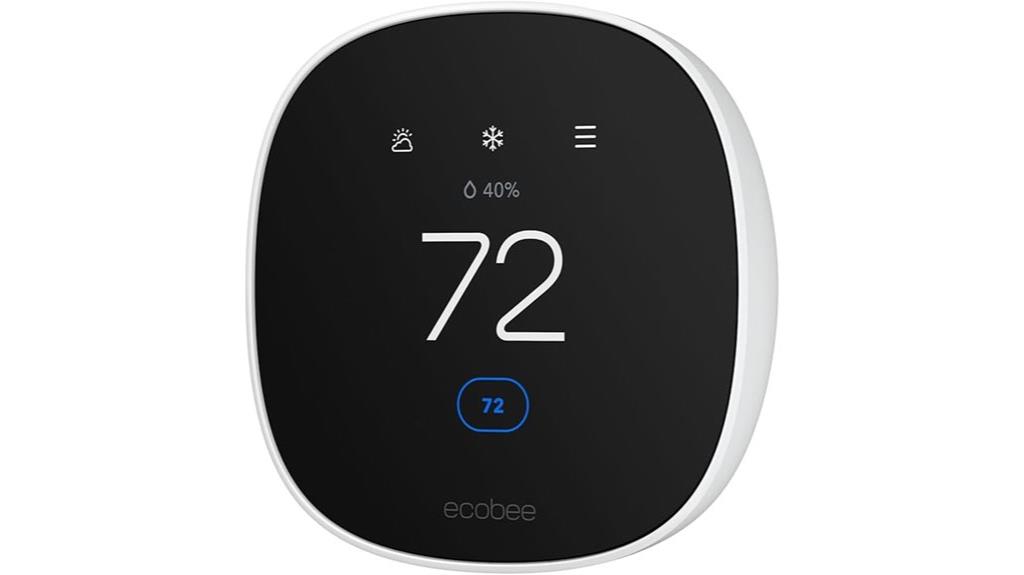
The ecobee Smart Thermostat Essential stands out as an excellent choice for homeowners seeking a budget-friendly, energy-efficient smart thermostat compatible with popular voice assistants. It’s Energy Star certified, Wi-Fi enabled, and works seamlessly with Siri, Alexa, Google Assistant, Apple HomeKit, iOS, and Android. With an intuitive LCD display, touch controls, and auto-scheduling, it simplifies managing heating and cooling. Designed for various systems like baseboard heaters, air conditioners, and furnaces, it helps save up to 23% on energy bills—often paying for itself within six months. Its straightforward installation and reliable app make it a popular, cost-effective upgrade for modern homes.
Best For: homeowners seeking an affordable, easy-to-install smart thermostat compatible with major voice assistants and capable of energy savings.
Pros:
- Energy Star certified, potentially saving up to 23% on utility bills
- Compatible with Siri, Alexa, Google Assistant, Apple HomeKit, iOS, and Android for seamless integration
- Simple DIY installation with intuitive app controls and scheduling features
Cons:
- Limited scheduling flexibility, allowing only one schedule per season
- Requires a C wire for power, which may need additional wiring or adapters
- Basic scheduling and feature options, lacking advanced customization and multi-season programming
meross Smart Thermostat for Home
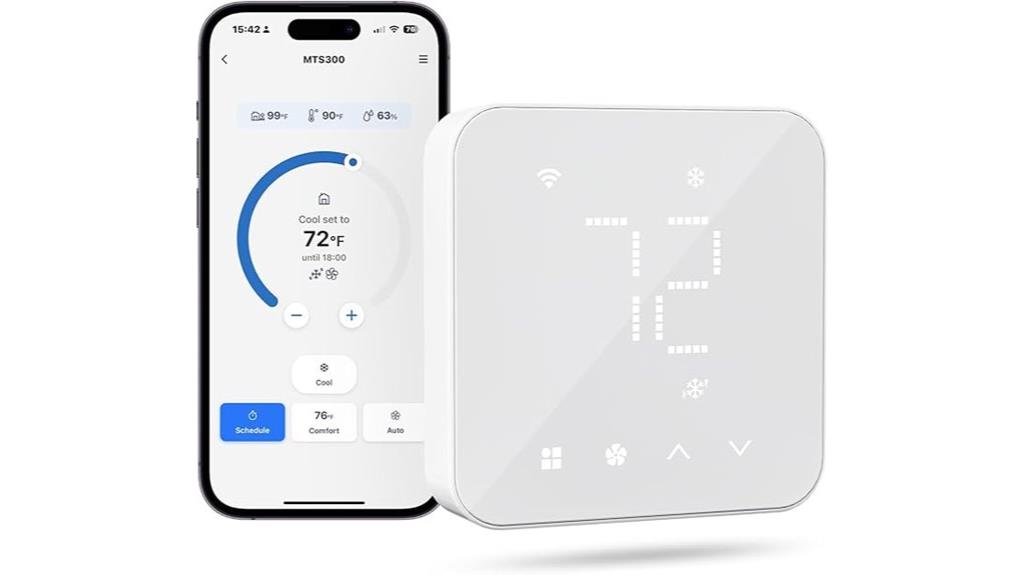
For homeowners seeking a reliable and easy-to-install smart thermostat compatible with most HVAC systems, the meross Smart Thermostat stands out. It works with 95% of systems, including conventional heating, cooling, and heat pumps, but not electric baseboard heaters. You’ll need a C-wire or a meross C-wire adapter for installation. It supports only 2.4GHz Wi-Fi, but offers customizable 7×24-hour schedules that run even without internet. With Matter support, it integrates seamlessly with Apple Home, Alexa, Google, and Samsung SmartThings, plus remote control via the app. It’s a solid choice for energy efficiency and convenient home climate management.
Best For: homeowners seeking a reliable, easy-to-install smart thermostat compatible with most HVAC systems and advanced home integration platforms.
Pros:
- Compatible with 95% of HVAC systems, including conventional heating, cooling, and heat pumps
- Supports Matter technology for seamless integration with Apple Home, Alexa, Google, and Samsung SmartThings
- Allows customizable 7×24-hour scheduling and remote control via the app, even without Wi-Fi
Cons:
- Not compatible with electric baseboard heaters
- Requires a C-wire or adapter for installation, which may add to setup complexity
- Supports only 2.4GHz Wi-Fi networks, limiting options in mixed network environments
Honeywell Wi-Fi Smart Color Thermostat
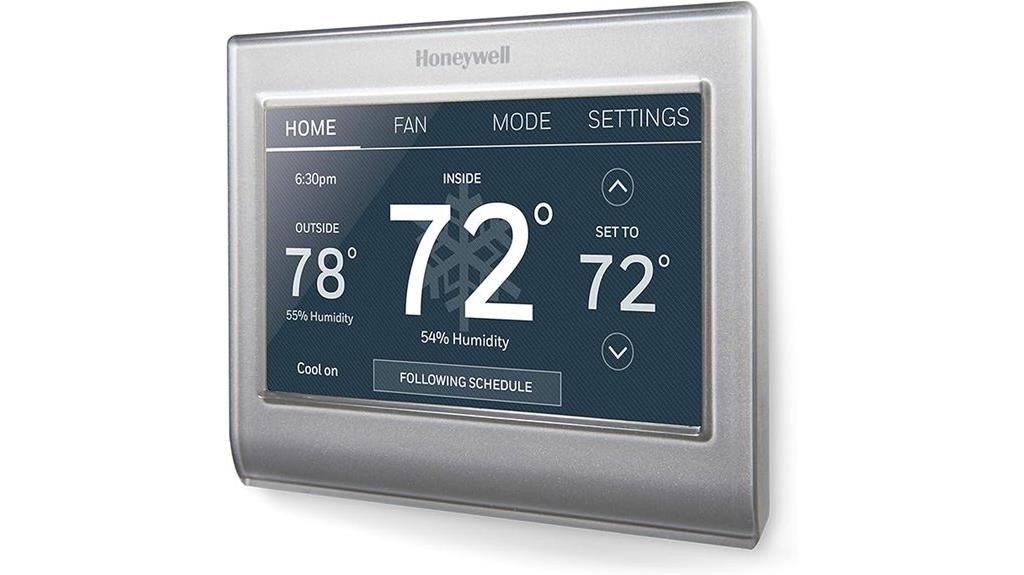
The Honeywell Wi-Fi Smart Color Thermostat stands out as an ideal choice for homeowners managing multiple properties or seeking centralized control over their HVAC systems. It offers a 7-day programmable schedule, a customizable full-color touchscreen, and supports Alexa, Google Home, SmartThings, and IFTTT integrations. With Wi-Fi remote access, I can monitor indoor temperature, outdoor weather, humidity, and forecasts from anywhere. Its straightforward installation, compatibility with heat pumps and central AC, and intuitive interface make it user-friendly. Although some wiring challenges exist, its sleek design, energy-saving features, and all-encompassing climate management make it a versatile option for multi-home control.
Best For: homeowners managing multiple properties or seeking centralized, remote control of their HVAC systems with customizable features and smart home integration.
Pros:
- User-friendly touchscreen interface with customizable colors and intuitive navigation
- Supports multiple smart home platforms like Alexa, Google Home, SmartThings, and IFTTT
- Remote access for monitoring and controlling temperature, humidity, and weather forecasts from anywhere
Cons:
- Installation can be challenging due to fragile wire connectors requiring careful handling
- Limited fan control options (ON, AUTO, CIRCULATING) and lack of remote sensor compatibility
- Some features and app functionalities may be region-specific, mainly optimized for the US market
ecobee Smart Thermostat Enhanced
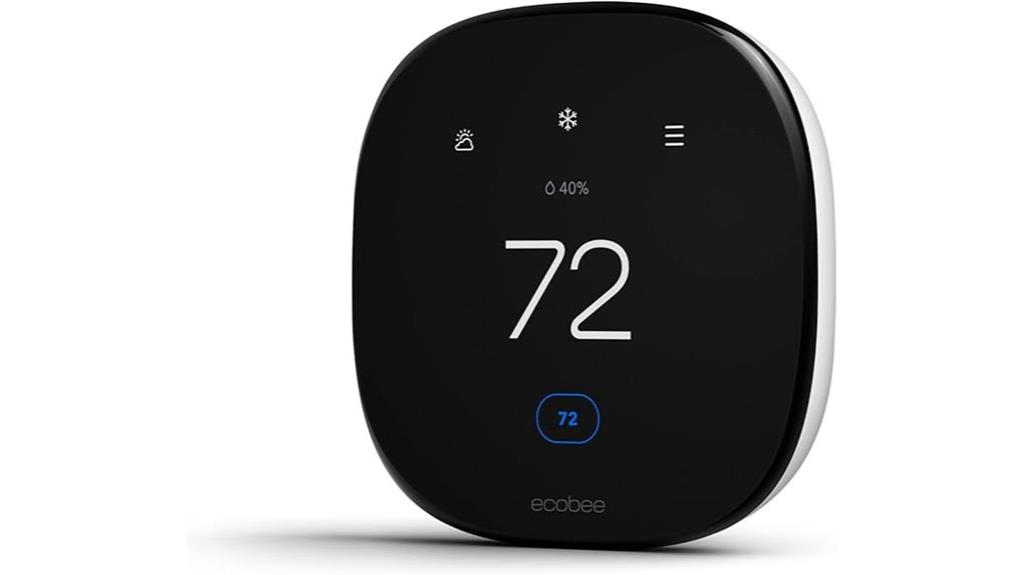
If you’re looking to optimize energy savings and maintain consistent comfort across multiple homes, the ecobee Smart Thermostat Enhanced is an excellent choice. It can save up to 26% annually on heating and cooling costs by automatically adjusting temperatures when your home is unoccupied. It preheats or cools your home before arrival and balances humidity for consistent comfort. With SmartSensor technology, it monitors room-specific temperatures, focusing on key areas. Compatible with major smart home platforms and controllable via the Ecobee app or voice commands, it’s easy to install, reliable, and compatible with most HVAC systems, making multi-home management simple and efficient.
Best For: homeowners and property managers seeking to maximize energy efficiency and comfort across multiple residences with smart, remote control capabilities.
Pros:
- Saves up to 26% annually on heating and cooling costs through automatic adjustments and humidity balancing.
- Compatible with most major smart home platforms and easy to control via app or voice commands.
- Easy to install with options like Power Extender Kit and supports a wide range of HVAC systems.
Cons:
- May require technical knowledge for installation, especially with the Power Extender Kit.
- Premium features and accessories like SmartSensor might involve additional costs.
- Compatibility could vary with older or less common HVAC systems.
Sensi Smart Thermostat
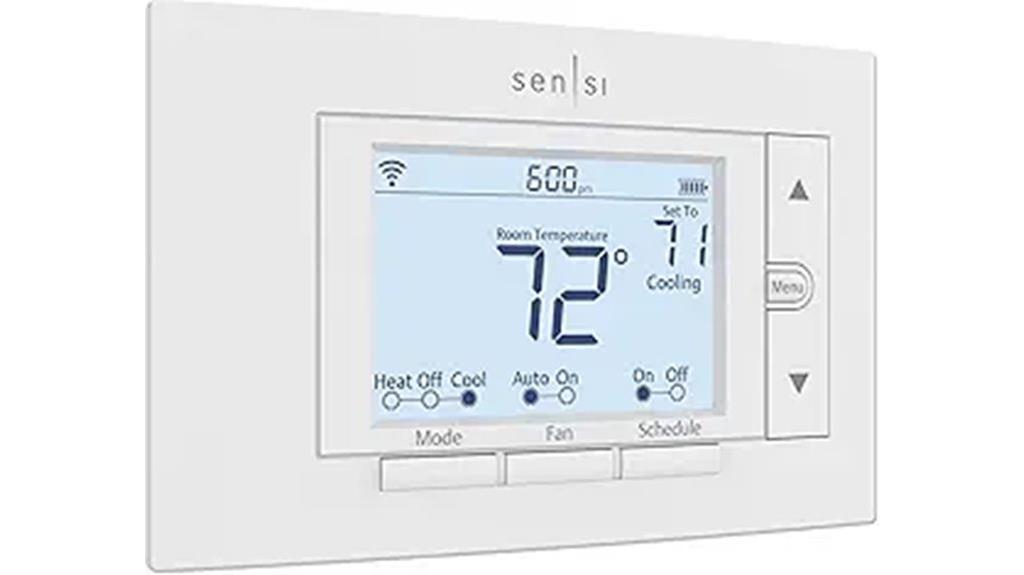
Those seeking an easy-to-install, Wi-Fi-enabled thermostat that offers reliable energy savings will find the Sensi Smart Thermostat an excellent choice. Its sleek design fits the same space as traditional models, making DIY installation simple without patching or painting. Compatible with most HVAC systems, often without a common wire, it features programmable scheduling, voice control with Alexa and Google Assistant, and energy reports that save about 23% on bills. The user-friendly app guides setup, wire labeling, and configuration, while the physical device offers manual controls and a bright LED display. Backed by a three-year warranty and built for dependable performance, it’s a smart, budget-friendly option.
Best For: homeowners seeking an easy-to-install, Wi-Fi-enabled thermostat that provides reliable energy savings and user-friendly control.
Pros:
- Easy DIY installation with step-by-step app guidance and hardware included
- Compatible with most HVAC systems, often requiring no common wire (c-wire)
- Energy Star certified, helping save approximately 23% on HVAC energy bills
Cons:
- Limited support for voice assistants like Bixby
- Some users experience occasional connectivity or setting adjustment issues
- Detailed energy usage data and customization options are somewhat limited
Honeywell Home T9 WiFi Smart Thermostat
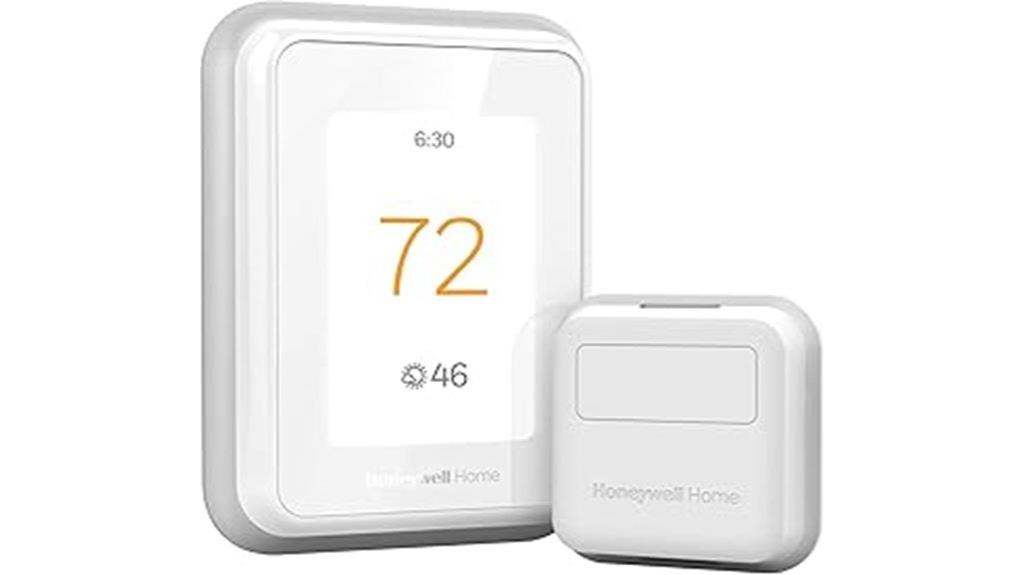
For homeowners managing multiple rooms or zones, the Honeywell Home T9 WiFi Smart Thermostat stands out thanks to its smart room sensors and multi-room control capabilities. These sensors monitor temperature and humidity in different areas, allowing me to focus comfort where it’s needed most. I can adjust settings via the Honeywell app, voice assistants, or directly on the touchscreen. Compatibility with various heating systems, including forced air, hot water, and heat pumps, makes it versatile. Although installation is straightforward, mounting sensors securely can be tricky. Overall, the T9 offers flexible control, energy savings, and a user-friendly experience, despite some Wi-Fi connectivity quirks.
Best For: homeowners seeking a versatile, multi-room smart thermostat with remote control, energy savings, and compatibility with various heating systems.
Pros:
- Supports multiple control methods including app, voice assistants, and touchscreen.
- Works with Honeywell Smart Room Sensors for focused comfort across different rooms.
- Compatible with a wide range of heating systems, including forced air, hot water, and heat pumps.
Cons:
- Mounting sensors securely can be challenging due to adhesive limitations.
- Wi-Fi connectivity issues, especially with 5GHz networks, may require troubleshooting.
- Higher price point, especially when adding multiple sensors and accessories.
Google Nest Thermostat, Programmable Wi-Fi Smart Thermostat
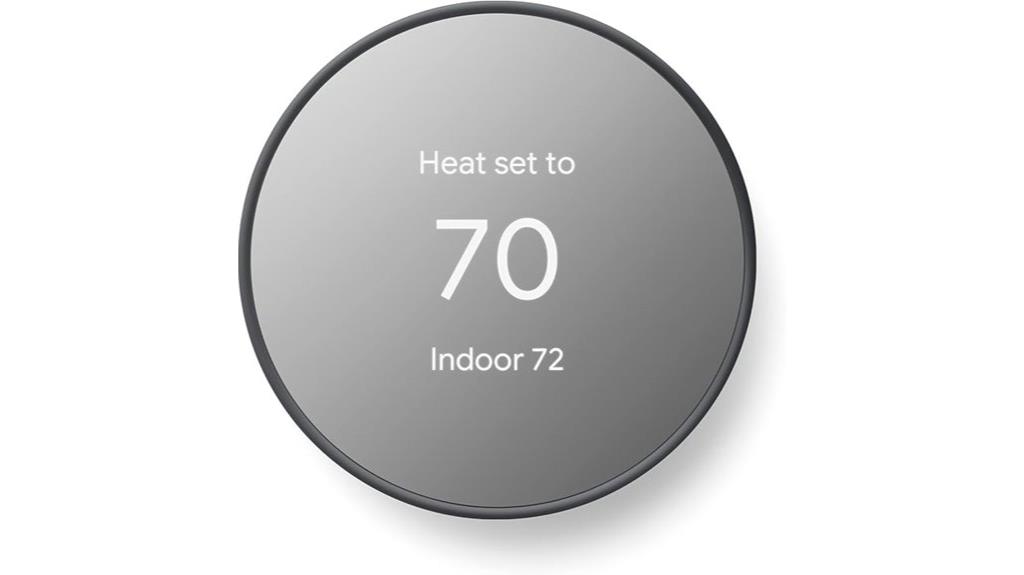
The Google Nest Thermostat stands out as an ideal choice for homeowners seeking a sleek, user-friendly smart thermostat that can be easily installed and managed remotely. It’s ENERGY STAR certified, supports Wi-Fi and Bluetooth, and works with HVAC systems with 2-stage heat or cooling. Installation typically takes less than 30 minutes, often without a C wire. The thermostat allows remote control via the Google Home app, supports voice commands through Google Assistant or Alexa, and learns your preferences over time to optimize comfort and savings. Its modern design, energy-saving features, and compatibility make it a versatile option for managing multiple properties effortlessly.
Best For: homeowners seeking an easy-to-install, energy-efficient smart thermostat that integrates seamlessly with Wi-Fi, voice control, and remote management.
Pros:
- Easy DIY installation typically completed in less than 30 minutes
- Supports remote control via the Google Home app and voice commands with Google Assistant or Alexa
- Learns user preferences over time to optimize comfort and energy savings
Cons:
- Requires Wi-Fi and internet connection for full remote functionality and notifications
- May need a C wire or power accessory for certain HVAC systems like heat pumps or zone controls
- Limited offline operation and potential connectivity issues can affect performance
Smart Wi-Fi Thermostat with App Control and Scheduling
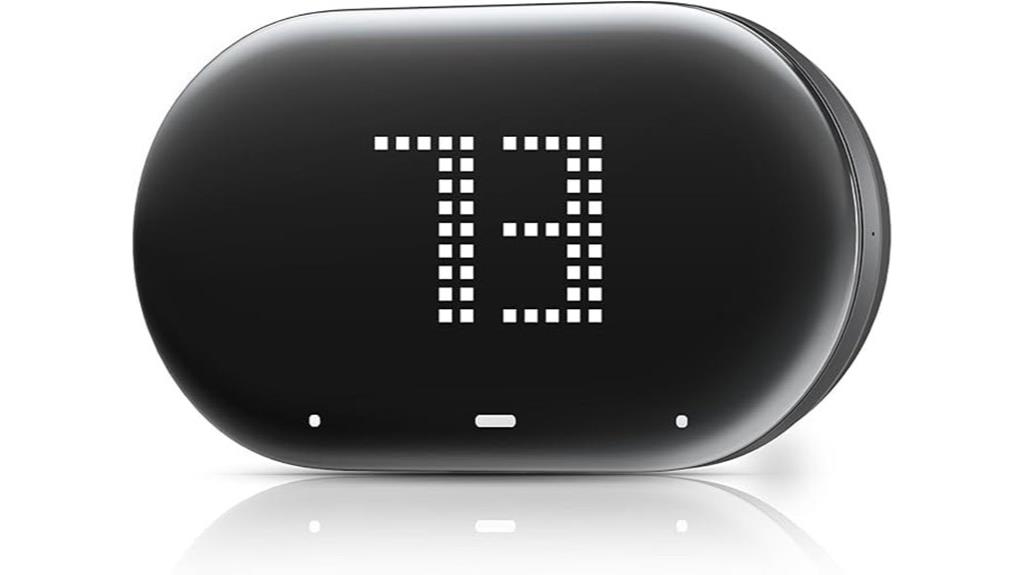
A smart Wi-Fi thermostat with app control and scheduling is ideal for homeowners who want seamless, remote management of their home’s climate. I love how it reduces energy costs by up to 27% through intelligent scheduling and provides detailed energy reports for smarter management. Compatible with most HVAC systems, it’s quick to install—just 15 minutes with the Degrii OS app’s AI wizard. You can control it from anywhere using the app, and it supports multiple users. Features like geofencing and child lock boost safety and efficiency. Its sleek black design fits well in any home, making it a reliable, feature-rich choice for modern living.
Best For: homeowners seeking an easy-to-install, energy-efficient smart thermostat with remote control and family-friendly safety features.
Pros:
- Reduces heating and cooling costs by up to 27% with intelligent scheduling.
- Compatible with 95% of HVAC systems and easy to install in just 15 minutes.
- Supports remote management and multi-user access via the Degrii OS app for convenience.
Cons:
- May require a stable Wi-Fi connection for optimal remote control functionality.
- Limited color options, with a sleek black design that might not match all decor styles.
- Advanced features like geofencing and child lock may require app updates or subscriptions.
Sensi Lite Smart Thermostat
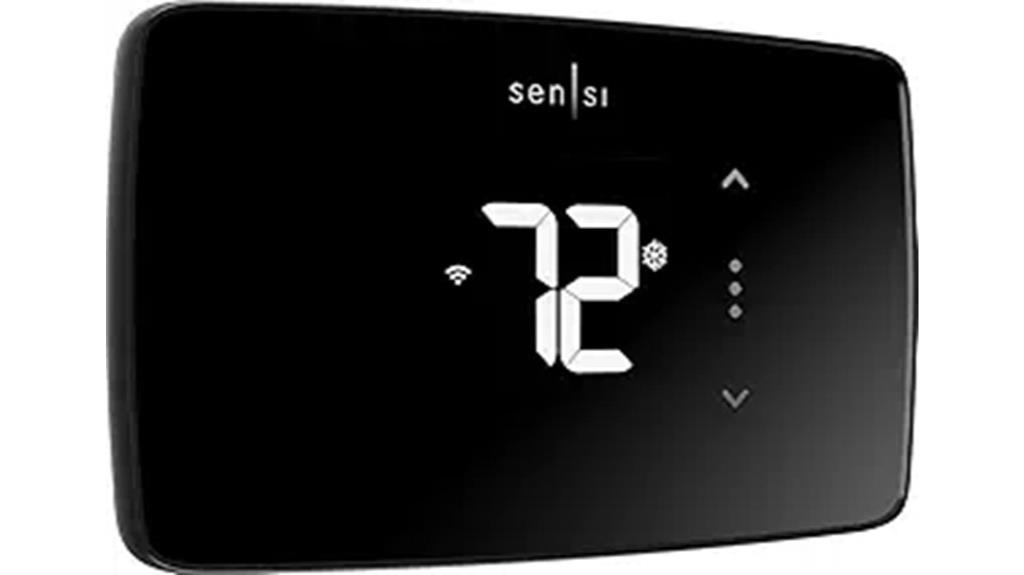
If you’re seeking a budget-friendly yet reliable smart thermostat that simplifies multi-home management, the Sensi Lite Smart Thermostat stands out. Made by Emerson and Energy Star Certified, it’s compatible with various HVAC systems, including boilers, heat pumps, and air conditioners. Easy to install with minimal wiring, it works with Wi-Fi, Alexa, Google Assistant, and SmartThings for remote control. Features like scheduling, geofencing, and filter alerts help save energy—around 23%. Its compact design and user-friendly app make managing multiple properties straightforward. While some connectivity hiccups exist, overall, it’s a cost-effective choice for those wanting simple, versatile control over multiple homes.
Best For: budget-conscious homeowners seeking an easy-to-install, versatile smart thermostat to manage multiple properties remotely.
Pros:
- Easy DIY installation with minimal wiring and clear instructions
- Compatible with a wide range of HVAC systems and supports app control via Wi-Fi, Alexa, Google Assistant, and SmartThings
- Energy-saving features like scheduling, geofencing, and filter alerts that can reduce HVAC energy use by approximately 23%
Cons:
- Occasional Wi-Fi connectivity issues, especially after power outages or battery changes
- Limited scheduling flexibility and app statistics compared to higher-end models
- Not recommended for use outside US/Canada and may require additional wiring adapters for complex or non-standard systems
Honeywell WiFi Smart Thermostat (RTH8800WF2022)
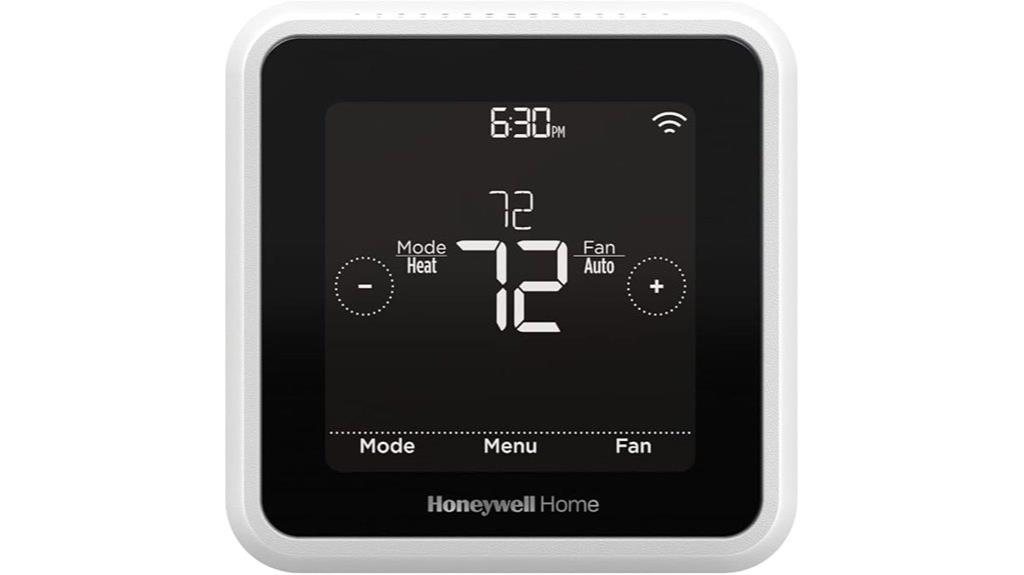
Looking for a smart thermostat that balances energy savings with flexible scheduling? The Honeywell WiFi Smart Thermostat (RTH8800WF2022) is a great choice. It features a 7-day programmable touchscreen, supports most heat/cool systems, and is Alexa ready. Its geofencing technology adjusts the temperature based on your location, saving energy when you’re away. Customers have saved 8-16% on bills thanks to its scheduling and smart features. Plus, it’s ENERGY STAR certified, promoting efficiency. Just remember, it requires a C-wire power adapter, so check compatibility beforehand. It’s easy to use, with personalized reports and voice control options for added convenience.
Best For: homeowners seeking an energy-efficient, customizable smart thermostat with easy scheduling and voice control.
Pros:
- Supports most heat/cool systems and is ENERGY STAR certified for energy savings.
- Features a user-friendly 7-day programmable touchscreen and Alexa compatibility.
- Utilizes geofencing technology to optimize comfort and reduce energy use when away.
Cons:
- Requires a C-wire power adapter, so compatibility should be verified before purchase.
- Not suitable for heating-only oil systems without a C-wire.
- Advanced features may require smartphone or internet connectivity for full functionality.
Emerson Sensi Touch Wi-Fi Smart Thermostat
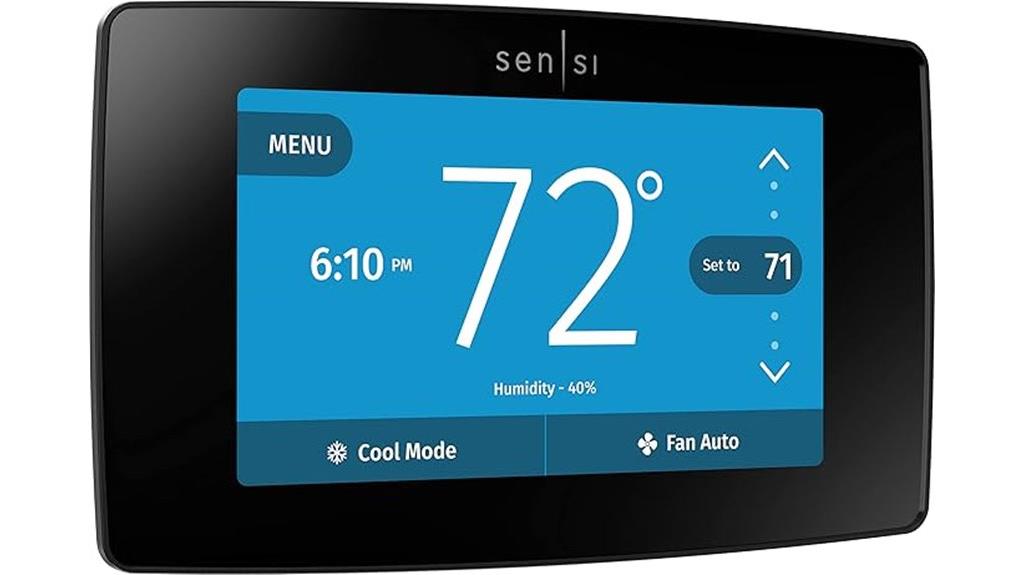
The Emerson Sensi Touch Wi-Fi Smart Thermostat stands out for homeowners who prioritize easy DIY installation combined with robust control options. Its large 4.3-inch color touchscreen makes managing your HVAC system straightforward, while the sleek design fits seamlessly into modern homes. Compatible with a wide range of systems, including boilers, heat pumps, and furnaces, it supports app control, voice commands via Alexa, Google Assistant, and Apple HomeKit. Energy Star certified, it can cut HVAC costs by around 23%. Setup is simple, especially with included hardware and guides, though a C-wire is essential for full functionality. Overall, it’s a reliable, energy-saving choice for multi-home management.
Best For: homeowners seeking an easy-to-install, versatile smart thermostat that offers remote control and energy savings.
Pros:
- Large 4.3-inch color touchscreen for easy operation and clear display
- Supports multiple control methods including app, voice commands, and manual touch
- Energy Star certified, helping reduce HVAC energy costs by approximately 23%
Cons:
- Requires a C-wire for full functionality; no battery-only operation available
- Registration and remote features can be limited outside North America, especially in EU regions
- Basic Apple HomeKit integration with limited schedule capabilities outside the US and Canada
Google Nest Learning Thermostat (4th Gen, 2024) with Nest Temperature Sensor
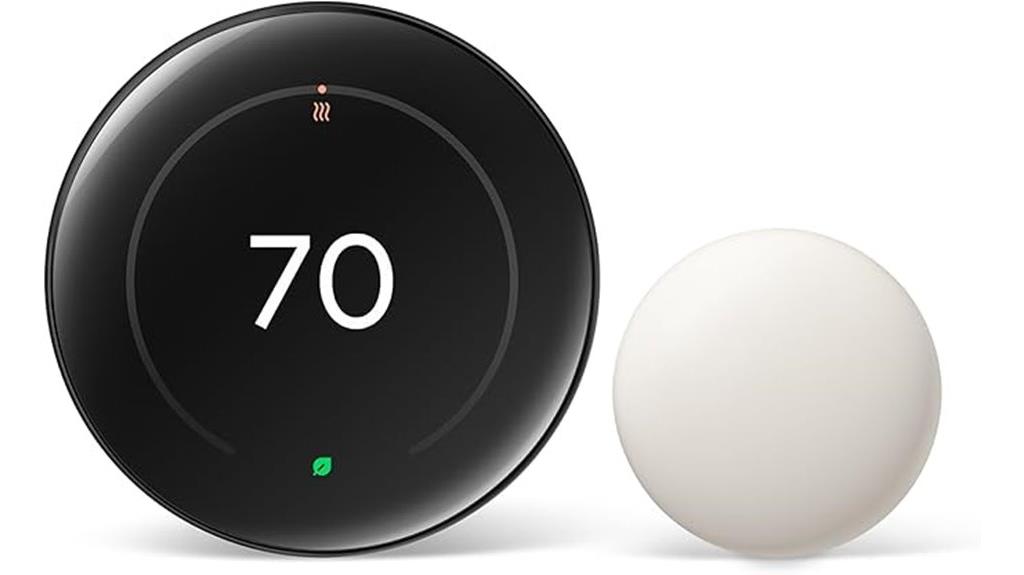
The Google Nest Learning Thermostat (4th Gen, 2024) with Nest Temperature Sensor stands out for those managing multiple homes, thanks to its ability to coordinate temperature control across different rooms and locations. Its larger display with Dynamic Farsight makes it easy to see important info from anywhere in the room, while customizable options like clock or weather displays enhance usability. It’s compatible with most 24V systems and integrates seamlessly with Alexa, Apple HomeKit, and Google Assistant, plus Matter. With remote control via the Google Home app and the ability to set sensors in various rooms, it simplifies multi-property management and optimizes energy savings effortlessly.
Best For: homeowners and property managers seeking an energy-efficient, smart thermostat with multi-room control and seamless integration across multiple properties.
Pros:
- Large, dynamic display with Farsight for easy visibility from across the room
- Compatible with multiple smart home ecosystems including Alexa, Apple HomeKit, and Google Assistant, plus Matter
- Supports multiple sensors for precise temperature control in different rooms and locations
Cons:
- May require professional installation if existing wiring is complex
- Slightly higher price point compared to basic thermostats
- Limited battery life in some environments, requiring occasional maintenance
Smart Thermostat with Room Sensor and Large Screen
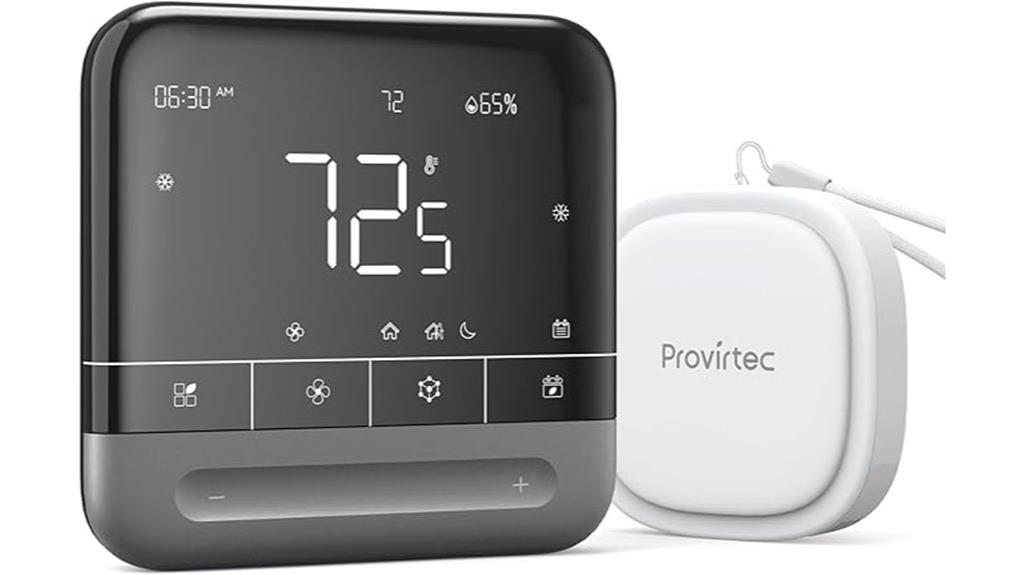
A smart thermostat with a large screen and room sensor is ideal for homeowners who prioritize easy control and precise temperature management. It supports over 95% of 24VAC HVAC systems, including central air, heat pumps, and furnaces, but requires a C wire for installation. Its 3.95-inch display provides clear visibility of settings, while the smart sliding touch design makes adjustments simple for everyone. Features include a 7-day schedule, Sleep/Home/Away modes, and real-time monitoring with Provirtec sensors. With WiFi and app control, you can manage your home’s climate remotely, saving energy and ensuring comfort effortlessly.
Best For: homeowners seeking an easy-to-use, precise thermostat with a large display and remote control capabilities for energy-efficient home climate management.
Pros:
- Supports over 95% of 24VAC HVAC systems, including central air, heat pumps, and furnaces.
- Large 3.95-inch screen with user-friendly sliding touch design for effortless adjustments.
- Features 7-day programmable schedule, Sleep/Home/Away modes, and real-time environmental monitoring via Provirtec sensors.
Cons:
- Requires a C wire for installation; not compatible with high-voltage or millivolt systems.
- Does not support S terminals for indoor/outdoor sensors.
- Firmware updates and sensor pairing require a WiFi connection, which may be disrupted during network outages.
Google Nest Learning Thermostat, 3rd Gen
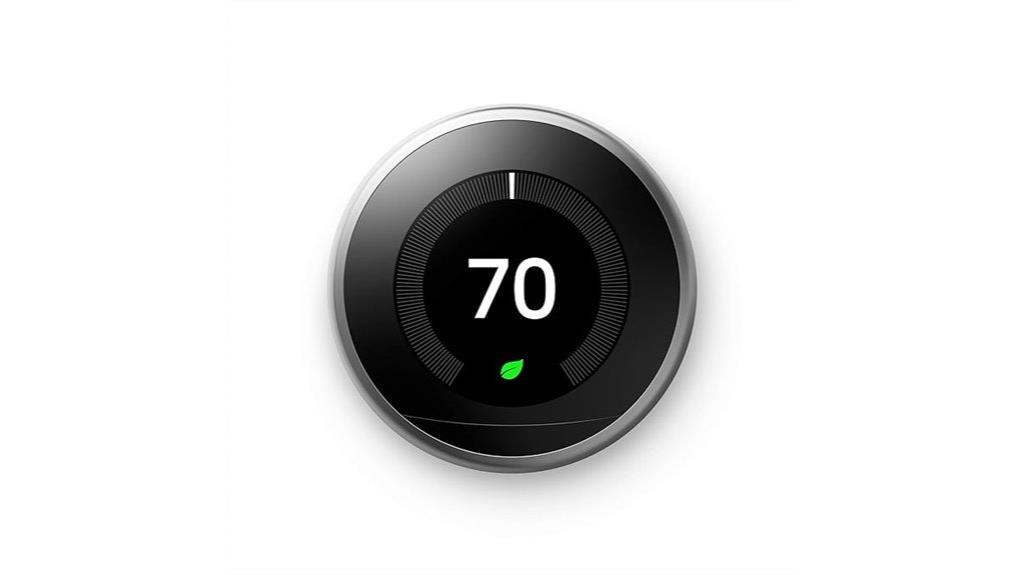
If you’re looking for a smart thermostat that learns your schedule and adapts to your preferences, the Google Nest Learning Thermostat 3rd Gen is an excellent choice. It automatically programs itself by observing your habits, saving you time and effort. You can view your energy usage history and see when you save the most, encouraging efficient choices with the Nest Leaf indicator. It also adjusts the temperature when you’re away, reducing energy waste. Plus, you can control it remotely via the Nest app from anywhere. Just make sure to verify compatibility with your system before buying, and you’ll enjoy a smarter, more efficient home.
Best For: those seeking a smart, energy-efficient thermostat that adapts to their schedule and can be controlled remotely.
Pros:
- Learns user preferences and automates scheduling for convenience
- Helps reduce energy consumption and lower utility bills with features like the Nest Leaf and Home/Away Assist
- Compatible with voice assistants like Alexa and controllable via the Nest app from anywhere
Cons:
- Requires compatibility verification before purchase to ensure proper installation
- May have a higher initial cost compared to traditional thermostats
- Some users might find the setup process complex or need professional installation
Factors to Consider When Choosing a Smart Thermostat With Multi‑Home Management
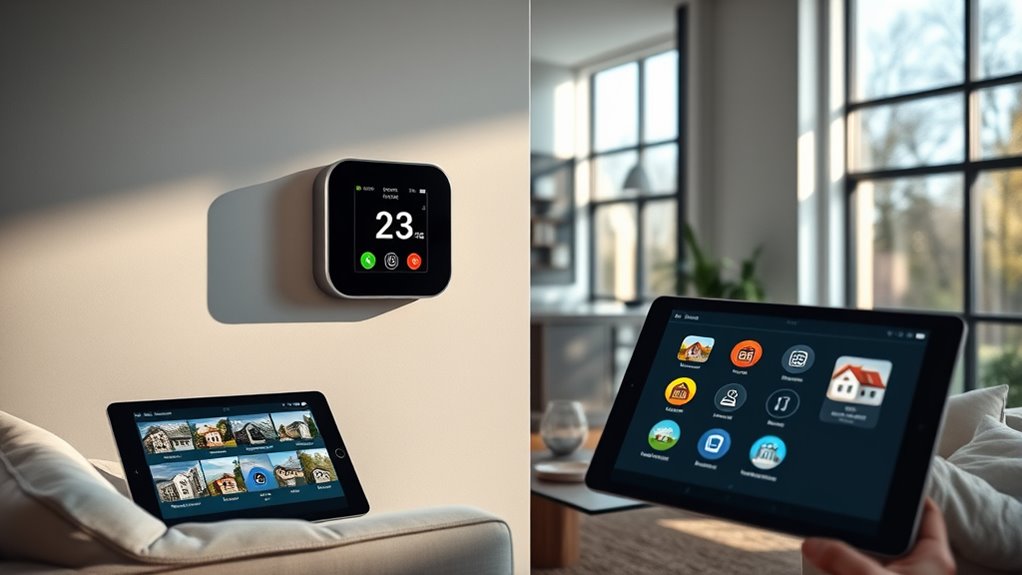
When selecting a smart thermostat for multiple homes, I consider key factors like compatibility with different systems and how easily I can control them remotely. I also look at sensor options, scheduling flexibility, and energy monitoring features to maximize efficiency. These points help guarantee I choose a device that fits my needs across all properties.
Multi-Home Compatibility
Choosing a smart thermostat for multi-home management requires careful attention to compatibility features that guarantee smooth operation across different properties. First, I look for devices supporting multi-zone or multi-room setups to effectively manage various areas within and across homes. Multi-user access is essential, so everyone—family members or property managers—can control and monitor each location independently. Compatibility with diverse HVAC systems, including central, ductless, or electric, is vital to assure seamless operation. I also check for a centralized app or platform that allows remote management and scheduling across multiple sites from one interface. Finally, multi-location geofencing and real-time alerts help optimize energy use and security, making multi-home management more efficient and stress-free.
Remote Access Ease
Remote access is a crucial feature to take into account because it determines how easily you can manage your smart thermostat from anywhere. I look for a dedicated app or platform compatible with my devices, ensuring I can make real-time temperature adjustments and schedule changes from anywhere with an internet connection. Multi-user support is also essential so my family or trusted users can manage settings remotely without hassle. Security is paramount, so I verify that the system uses encrypted connections and user authentication to protect my home. Notifications or alerts for system issues or unusual activity are a bonus, providing peace of mind and quick responses. Overall, seamless, secure remote access makes managing multiple properties more convenient and efficient.
Sensor Integration Options
Sensor integration options can substantially impact how well a smart thermostat manages multiple zones across different properties. Some thermostats support external sensors, allowing me to monitor multiple rooms for more precise control, while others rely solely on internal sensors. Many models offer room sensors that can be placed throughout the home, helping optimize comfort and energy efficiency. Compatibility with various sensor types, like humidity or motion sensors, can also enhance occupancy detection and climate management. Certain systems enable multi-sensor setups that work together to create an average temperature, balancing comfort across zones. Additionally, the ability to integrate third-party or proprietary sensors depends on the thermostat’s platform, with some supporting open standards like Matter for broader compatibility. Choosing the right sensor options is key to effective multi-home management.
Scheduling Flexibility
When managing multiple homes, having a smart thermostat with flexible scheduling can make all the difference in maintaining comfort and saving energy. A good schedule lets you set different temperature routines for each day or time period, optimizing comfort and efficiency. Some thermostats support multiple schedules per day or season, giving you precise control over heating and cooling patterns. The ability to easily modify or override schedules remotely adds convenience for changing plans or unexpected events. Advanced options like geofencing automatically adjust temperatures based on your location, preventing unnecessary energy use. However, be mindful of limitations such as restricted schedules or fixed time intervals, which can reduce customization and impact both comfort and energy savings.
Energy Monitoring Features
Choosing a smart thermostat with robust energy monitoring features is essential for effectively managing multiple homes. These devices provide detailed energy consumption reports, allowing me to track and optimize usage across properties. Real-time energy monitoring helps identify inefficiencies, so I can adjust settings to reduce heating and cooling costs. Features like usage history, cost estimates, and energy-saving suggestions make it easier to manage multiple locations efficiently. Compatibility with platforms that aggregate data from different homes offers a thorough view of energy performance, simplifying oversight. Advanced models can even preheat or precool spaces based on occupancy patterns, maximizing energy savings. Prioritizing these features ensures I stay informed about my energy use and take proactive steps to improve efficiency across all my properties.
System Compatibility
Ensuring your smart thermostat is compatible with your existing HVAC system is vital for reliable and efficient multi-home management. You need to check if it supports your system’s voltage, wiring, and control terminals, such as 24VAC, millivolt, or high-voltage setups. It’s also important to see if the device supports multi-zone or multi-room configurations, including additional sensors for precise control. Compatibility with your smart home ecosystem—like Alexa, Google Assistant, or Apple HomeKit—is essential for seamless integration. Additionally, verify if the thermostat can manage multiple properties remotely through a single app or account, simplifying control. Don’t forget to review system requirements for C-wire or power adapters, especially if your homes lack common wiring, to make sure the thermostat works reliably across all locations.
Frequently Asked Questions
How Do Smart Thermostats Integrate With Existing Security Systems?
Smart thermostats typically integrate with existing security systems through Wi-Fi or Z-Wave protocols, allowing seamless communication between devices. I connect mine via a compatible hub or app, enabling me to control heating and cooling remotely while monitoring security features like cameras or alarms. This integration provides a cohesive system, giving me peace of mind and easy management of my home’s comfort and security all in one place.
Can Multiple Users Control the Thermostats Remotely?
Can multiple users control the thermostats remotely? Absolutely! Most smart thermostats allow multiple users to access and manage settings via smartphone apps or web portals. This makes it easy for family members, property managers, or maintenance teams to adjust temperatures, set schedules, or troubleshoot issues from anywhere. It’s all about convenience, collaboration, and ensuring everyone stays comfortable without being physically present.
What Security Measures Protect My Home Network From Smart Thermostat Vulnerabilities?
When it comes to protecting my home network from smart thermostat vulnerabilities, I prioritize strong security measures. I make sure my Wi-Fi has a unique, complex password and enable WPA3 encryption. Regular firmware updates are vital, as they patch security flaws. I also use a separate network or VLAN for my smart devices, preventing potential breaches from spreading. Finally, I enable two-factor authentication whenever possible for added protection.
Are There Energy-Saving Features Specific to Multi-Home Management?
Did you know that smart thermostats can cut energy bills by up to 10-15%? When managing multiple homes, I look for features like customizable schedules and remote control, which optimize energy use across properties. Multi-home thermostats often include sensors that adapt to occupancy, saving energy when spaces are empty. These features help me stay efficient without sacrificing comfort, making multi-home management smarter and more cost-effective.
How Do Smart Thermostats Handle Inconsistent Wi-Fi Connections Across Properties?
Handling inconsistent Wi-Fi across properties, I’ve found that smart thermostats often use cellular connectivity or offline modes to keep working smoothly. They store settings locally and sync once the connection stabilizes. I recommend choosing models with robust offline features and multiple connectivity options. This way, even if Wi-Fi drops temporarily, your heating and cooling remain efficient and manageable, giving you peace of mind across all your properties.
Conclusion
So, after all this, it’s amusing how something as simple as controlling multiple homes can become so complex—and yet, with these smart thermostats, it’s almost effortless. Who would’ve thought that managing comfort across properties would require a gadget? But hey, if you enjoy the irony of tech making life easier while complicating choices, you’re in luck. Trust me, your future self will thank you for choosing the right one—preferably before your thermostat throws a tantrum.


